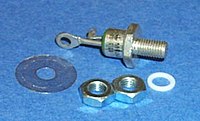
Photo from wikipedia
In this letter, two different switching modes are identified for RF synchronous rectifier circuits which lead to a change in the polarity of the rectified output voltage. The operation of… Click to show full abstract
In this letter, two different switching modes are identified for RF synchronous rectifier circuits which lead to a change in the polarity of the rectified output voltage. The operation of the two modes is defined in terms of the dynamic current–voltage (I–V) characteristics of the switching device and the polarity of the output load voltage. In one mode, the dc output voltage is positive and associated with a switching condition where the device is ON in quadrant-III and OFF in quadrant-I. This mode of operation has been reported widely in the literature. In the second mode, the quadrants associated with the on- and off-state are swapped leading to a polarity reversal across the load. Theoretical justification for the two modes is given and the experimental results are shown to confirm the two different switching modes in the synchronous rectifier. Experiments with a GaN inverse class-F rectifier were made to verify the theory, and both modes have similar measured peak rectification efficiencies of 77% at a frequency of 1.8 GHz.
Journal Title: IEEE Microwave and Wireless Components Letters
Year Published: 2017
Link to full text (if available)
Share on Social Media: Sign Up to like & get
recommendations!